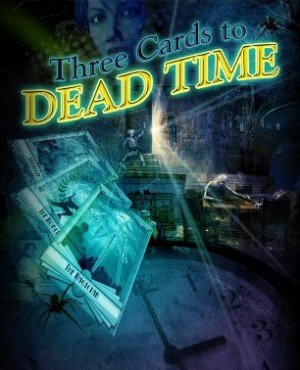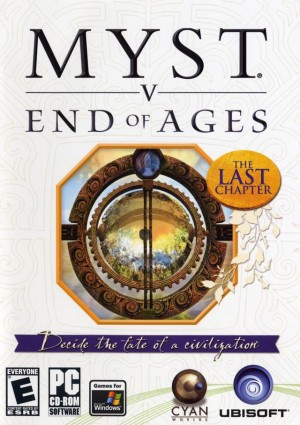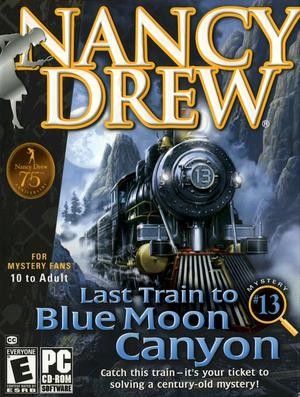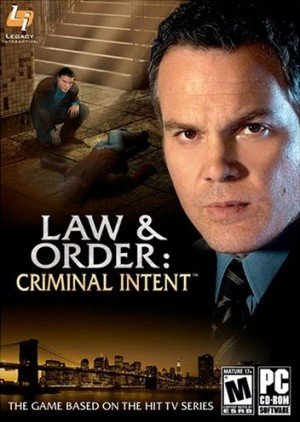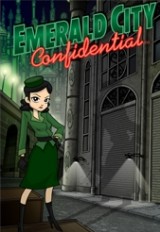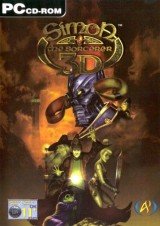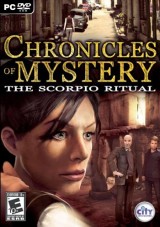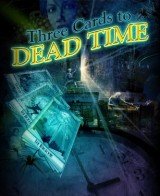Review for 3 Cards to Dead Time

Episodic gaming and digital distribution have certainly revolutionized the games market. This explains why, after almost ten years of silence, players can now enjoy the second game from the pens of Chris Jones and Aaron Conners (of Tex Murphy fame) in less than eight months. Hot on the heels of 3 Cards to Midnight, now the sequel has reached our monitors, and like its predecessor, it delivers a solid script virtually dripping with mystery and atmosphere, enough twists to make your head spin and a couple of really likeable characters. However, 3 Cards to Dead Time sometimes falls short of its own ambition, with production values that seem to have gone backwards, gameplay that is not as seamlessly integrated with the plot and a story that, while surely entertaining, is given a rather trite resolution.
Note: The following paragraph contains some potential spoilers for 3 Cards to Midnight
.At the end of the previous game, Jess Silloway – a young woman who discovered her gift to bend time and space during a shocking near-death experience – confronted a twisted abomination named Ylli after learning of the close connection they share. Only by tapping into her previously dormant power was Jess able to defeat this unexpected nemesis. But Jess still didn’t know much about the source of her psychic abilities or her disturbing legacy at the time. Since then, with the mastermind behind the original scheme still searching for her, she has spent the last few months travelling safely with her parents, never staying too long in the same place for fear of being found. But when she starts receiving ghostly messages from the beyond, she must get out from hiding and finally confront her past: who is the faceless woman that visits her dreams? Why is she trying to communicate with Jess? And what is the relevance of Beacon Bay, an almost deserted coastal town in Maine, now a favorite destination of ghost-hunters?
If you're not familiar with 3 Cards to Midnight, this brief synopsis may seem a tad too esoteric, but fret not, because – while it's certainly advisable to play the games in order – 3 Cards to Dead Time opens with a nice recap of the story that will help newcomers settle right in. Well, sort of. Many plot details are left a bit vague, and while I understand this choice, given that Jess' goal is to figure out the answers to these questions on her own, chances are that non-returning players will be slightly taken aback by the intricacies of the new story, and it takes a while to get accustomed to the particular mythology of this adventure and Jess' badly messed-up genealogical tree. If you did play the first game and thought that Jess' past was really complicated, you haven't seen anything yet: here you’ll find entire towns wiped out in the blink of an eye, enigmatic disappearances, messages from the afterlife, séances and ghost-hunters, arcane artifacts and diabolical rituals… there's something in this dish to whet the appetite of every mystery or sci-fi buff.
Newcomers may be even more abashed by the gameplay than by Jess' convoluted background. 3 Cards to Dead Time continues down the road established in the first game, with a mix of traditional (and often tough) adventure-style puzzles and casual elements in the form of a unique word-based variation of the typical hidden object formula. However, where the first game presented a rather seamless integration of story and gameplay – a goal clearly set by the developers, who label these efforts as "story games" – the union is less synchronized this time around. This detachment between plot developments and game mechanics, although not as severe as in an ordinary “HOG” (hidden object game), is what prevents 3 Cards to Dead Time from reaching the higher standards of its precursor.
In 3 Cards to Midnight, Jess was suffering from a violent form of selective amnesia, and the process of restoring her memories by word associations worked perfectly both as a plot device and a refreshing, intriguing gameplay gimmick. This time around, Jess uses the same tool as before – a deck of tarot cards – but with a different goal: instead of searching for her lost past, she is trying to figure what to do next and each card represents a place she must visit, a clue she has to find or a person who needs to speak to her. Once Jess selects one of the (two or three) cards available in a given chapter, the player must carefully comb the screen in search of objects that fall within certain categories displayed on screen, such as "Objects that produce smoke" or "Objects of superstition".
After each category has been completed – the wide-ranging number of items to find depends on the chosen level of difficulty – a cinematic scene plays out, moving the story forwards. This is when the problems start, since the connection between the item category and the unveiled portion of the story is often stretched thin, to say the least. Finding many "Objects that come in 5s" to discover that in 1929, five important people disappeared from Beacon Bay seems acceptable enough, but scouring Jess' apartment to find "Objects that deter a thief" only because Jess snatched an old, battered photo out of an abandoned hotel struck me as way too contrived. And when I found out in a cutscene why I was looking for "Objects with an antenna", the connection was laughable, though not in a good way. Thankfully, this gets better as the game progresses, mainly because the categories start to be more coherent with the dark atmosphere of the setting (torture devices, magical paraphernalia, etc.), but unlike the first game, 3 Cards to Dead Time from time to time feels more like a HOG that is trying way too hard to camouflage itself.
This is a pity, because aside from their less-than-perfect integration within the storyline, these segments are actually quite entertaining. The developers even listened to complaints about the original and added more variety. You’ll still spend some of your time searching for thematic or semantic connections rather than specific objects, a process which is both more challenging and more rewarding. For example, you will be asked to find three objects that share a link to the word "King", be it the crowned type or the chess piece, or the word "Heart" that may represent the organ as well as the playing card suit. Other times you will sift through various locales like a damp, musty cellar or a tumbledown lighthouse to find pairs of opposite words or concepts, like night and day or moon and sun. While equally disconnected from the plot developments, these diverse tasks help the game stay fresher, avoiding the repetitiveness that hampered the original.
Once every category has been completed, often a standalone puzzle opens up to solve or skip. Although skipping puzzles lowers the score associated with each card/location, I found no place where the score, so pivotal in 3 Cards to Midnight, plays any role at all this time. The puzzles themselves vary greatly both in quality and difficulty: some of them are the usual fare of every adventure, like tile puzzles, jigsaws and even some unwelcome musical conundrums, which are often pretty bland. Others, fortunately, are more imaginative and challenging. I particularly liked the one involving an angry bee that the player had to get rid of in a creative, color-based (and really hard) way, and a real brain-teaser involving four planets of the solar system, their orbits and different times of revolution.
The gameplay element I appreciated the most, though, are the choices given to the player. Multiple times throughout the adventure, Jess is presented with a crossroad and the game states very clearly that once a direction is chosen, there is no going back. These choices can be as easy as deciding what tarot card to explore first, or they can be more subtle and thought-provoking: after running away from danger, where will Jess go? Will she go after her loving boyfriend Daniel? Or she will page returning P.I. Merryman to continue the investigation? Of course, the most significant choice happens near the end of the game, but I won't spoil it for you: suffice to say that each possibility is intriguing and well thought-out, and requires a lot of attention from the player to make the "right" decision. These multiple crossroads mean that 3 Cards to Dead Time offers a good deal of replayability, and since the game is quite short – I completed it in no more than four hours – there's really no reason not to try out the possible different outcomes, though the word lists and object placement throughout are the same each time.
What likely won't invite playing again are the game’s graphics, which are not only far from the highest eye-candy standards of today, but even sub-par when compared to 3 Cards to Midnight in some respects. The resolution is higher now and the interface is as stylishly designed as before, but the backgrounds are still a bit murky and grainy, and the interactive objects remain pixelated, making it sometimes difficult to identify them. Unfortunately, almost entirely gone is the admirable artistic design of the first title. The backgrounds may be more detailed, but the scary atmosphere the game strives to deliver with its gloomy themes and eerie sound effects is often hampered by questionable issues like object proportions being wrong. What’s worse, the animations that enlivened the first title are sparse this time, and the cinematics that were wonderfully directed in Midnight have now been reduced to a series of stills. While I perfectly understand the budgetary reasons behind these choices, the lack of cinematic feeling – which has always been key component of Aaron Conners and Chris Jones' adventures – further hinder the ambiance.
The music certainly fares better, with eerie orchestrations and ominous tunes that almost make up for the lacking visuals. Voice acting is generally well done also – Jones and Conners themselves are perfect as the voices of Merryman and Daniel, and their lines are easily the best of the game – but there are two notable exceptions. First there is a French character that speaks like a bad Gérard Depardieu caricature, but fortunately he has very few lines. The second exception is way more severe as it regards a pivotal character (which I won't name), who sounds like he's constantly using the voice-distorter every bad guy in every C-movie always uses, often with unintentionally comical results. The situation isn't that bad here, but this particular voiceover lessened an otherwise enigmatically twisted character, and hampered his impact on the story.
I’ve avoided spoilers as much as possible because the game is really filled with unexpected developments, breathtaking cliffhangers between the seven chapters and so many twists and spins that even the most seasoned adventurer will need to peek at the story summary once in a while. Admittedly, not everything that goes around comes around (some space-time oddities are never fully explained, and the precise nature of Jess' gift is still extremely vague), and the plot becomes rather predictable near the end. Perhaps even a bit cheap, as is often the case when one tries too hard to explain a supernatural phenomenon. Despite this, however, the story is undoubtedly the game's strongest selling point and the solid script – Aaron Conners’ writing is as sharp as ever – coupled with a bunch of really amiable characters (Jess and Daniel, mainly), will grab your attention tight and keep you on the edge of your seat, shocking surprise after shocking surprise, until the end.
All in all, while 3 Cards to Dead Time is another good entry in this new series, it lacks the polish of the first title when it comes to both art direction and gameplay integration. It goes without saying that if you didn't like the casual feel of 3 Cards to Midnight, you won't find anything here to appease your tastes, but even fans of the first game may be slightly put off by the sometimes menial nature of the puzzles and the poor integration of story and game mechanics. Nevertheless, fans of casual games will find an intriguing little title that will test their grey cells more than their keen eyes, all the while entertaining them with a captivating horror romp where every choice matters, and this is a thing that almost no other adventure of today – traditional, casual, or anything in between – can say.


